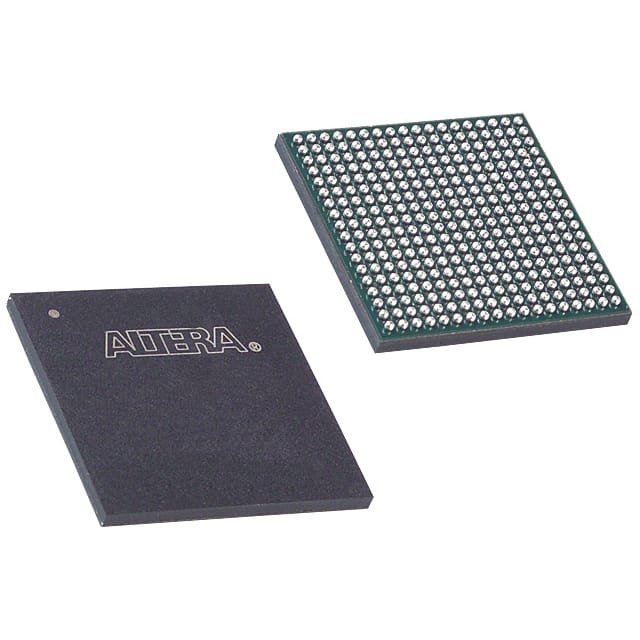EP4CGX30CF19C6N
Product Overview
- Category: Programmable Logic Device (PLD)
- Use: EP4CGX30CF19C6N is a PLD used for digital logic design and implementation.
- Characteristics: It offers high performance, low power consumption, and flexibility in designing complex digital systems.
- Package: The EP4CGX30CF19C6N comes in a compact 324-ball FineLine BGA package.
- Essence: This PLD provides a reconfigurable hardware platform for implementing various digital functions.
- Packaging/Quantity: The EP4CGX30CF19C6N is typically sold individually or in small quantities.
Specifications
- Logic Elements: The EP4CGX30CF19C6N contains 29,440 logic elements.
- Embedded Memory: It has 1,152 Kbits of embedded memory.
- PLLs: This PLD features four phase-locked loops (PLLs).
- I/O Pins: It provides 202 user I/O pins.
- Operating Voltage: The EP4CGX30CF19C6N operates at 1.2V core voltage and 3.3V I/O voltage.
- Speed Grade: It is available in various speed grades, with the maximum operating frequency up to 400 MHz.
Pin Configuration
The EP4CGX30CF19C6N has a detailed pin configuration as follows:

Functional Features
- Reconfigurability: EP4CGX30CF19C6N allows users to modify the functionality of the device even after it has been programmed.
- High Performance: It offers fast processing speeds and efficient utilization of resources.
- Low Power Consumption: The PLD is designed to minimize power consumption, making it suitable for battery-powered applications.
- Flexible I/O Options: EP4CGX30CF19C6N provides a wide range of I/O options, including LVCMOS, LVTTL, and differential signaling standards.
Advantages and Disadvantages
Advantages: - Versatile and flexible design capabilities - High-performance processing - Low power consumption - Reconfigurable nature allows for easy updates and modifications
Disadvantages: - Initial learning curve for programming and utilizing the PLD effectively - Limited availability of alternative models with similar specifications
Working Principles
The EP4CGX30CF19C6N operates based on the principles of field-programmable gate arrays (FPGAs). It consists of an array of configurable logic blocks (CLBs) interconnected through programmable interconnects. Users can program the device using hardware description languages (HDLs) or graphical tools to define the desired digital logic functions. Once programmed, the PLD executes the specified logic operations.
Application Field Plans
EP4CGX30CF19C6N finds applications in various fields, including: 1. Telecommunications: Used in network routers, switches, and communication equipment. 2. Industrial Automation: Employed in control systems, robotics, and process automation. 3. Automotive: Utilized in automotive electronics for engine control, infotainment systems, and driver assistance. 4. Aerospace: Used in avionics systems, satellite communication, and flight control. 5. Consumer Electronics: Applied in smart devices, gaming consoles, and multimedia systems.
Alternative Models
While EP4CGX30CF19C6N is a unique model, there are alternative PLDs available with similar specifications, including: - EP4CE30F29C6N - EP4SGX30CF19C6N - EP4CGX50CF23C6N
These alternative models offer different logic capacity, I/O pin counts, or additional features to suit specific design requirements.
In conclusion, the EP4CGX30CF19C6N is a versatile and high-performance programmable logic device. Its reconfigurable nature, low power consumption, and flexible I/O options make it suitable for a wide range of digital logic applications in various industries.
Lista 10 Vanliga frågor och svar relaterade till tillämpningen av EP4CGX30CF19C6N i tekniska lösningar
Sure! Here are 10 common questions and answers related to the application of EP4CGX30CF19C6N in technical solutions:
Q: What is EP4CGX30CF19C6N? A: EP4CGX30CF19C6N is a specific model of Field-Programmable Gate Array (FPGA) manufactured by Intel.
Q: What are the key features of EP4CGX30CF19C6N? A: Some key features of EP4CGX30CF19C6N include 30,080 logic elements, 1,152 Kbits of embedded memory, and support for various I/O standards.
Q: What are the typical applications of EP4CGX30CF19C6N? A: EP4CGX30CF19C6N can be used in a wide range of applications such as industrial automation, telecommunications, automotive systems, and high-performance computing.
Q: How can EP4CGX30CF19C6N be programmed? A: EP4CGX30CF19C6N can be programmed using Hardware Description Languages (HDLs) like VHDL or Verilog, which describe the desired functionality of the FPGA.
Q: Can EP4CGX30CF19C6N be reprogrammed after deployment? A: Yes, EP4CGX30CF19C6N is a reprogrammable FPGA, allowing for flexibility and updates to the design even after deployment.
Q: What tools are available for programming EP4CGX30CF19C6N? A: Intel provides Quartus Prime software suite, which includes development tools for designing, simulating, and programming EP4CGX30CF19C6N.
Q: What is the power consumption of EP4CGX30CF19C6N? A: The power consumption of EP4CGX30CF19C6N depends on the specific design and usage, but it typically ranges from a few watts to tens of watts.
Q: Can EP4CGX30CF19C6N interface with other components or devices? A: Yes, EP4CGX30CF19C6N supports various I/O standards, allowing it to interface with other components or devices such as sensors, memory, or communication interfaces.
Q: Are there any limitations or considerations when using EP4CGX30CF19C6N? A: Some considerations include the need for proper cooling due to power dissipation, understanding the FPGA's timing constraints, and ensuring compatibility with other system components.
Q: Where can I find more information about EP4CGX30CF19C6N? A: You can refer to the official documentation provided by Intel, including datasheets, user guides, and application notes, which are available on their website.
Please note that the specific details and answers may vary depending on the context and requirements of the technical solution.


